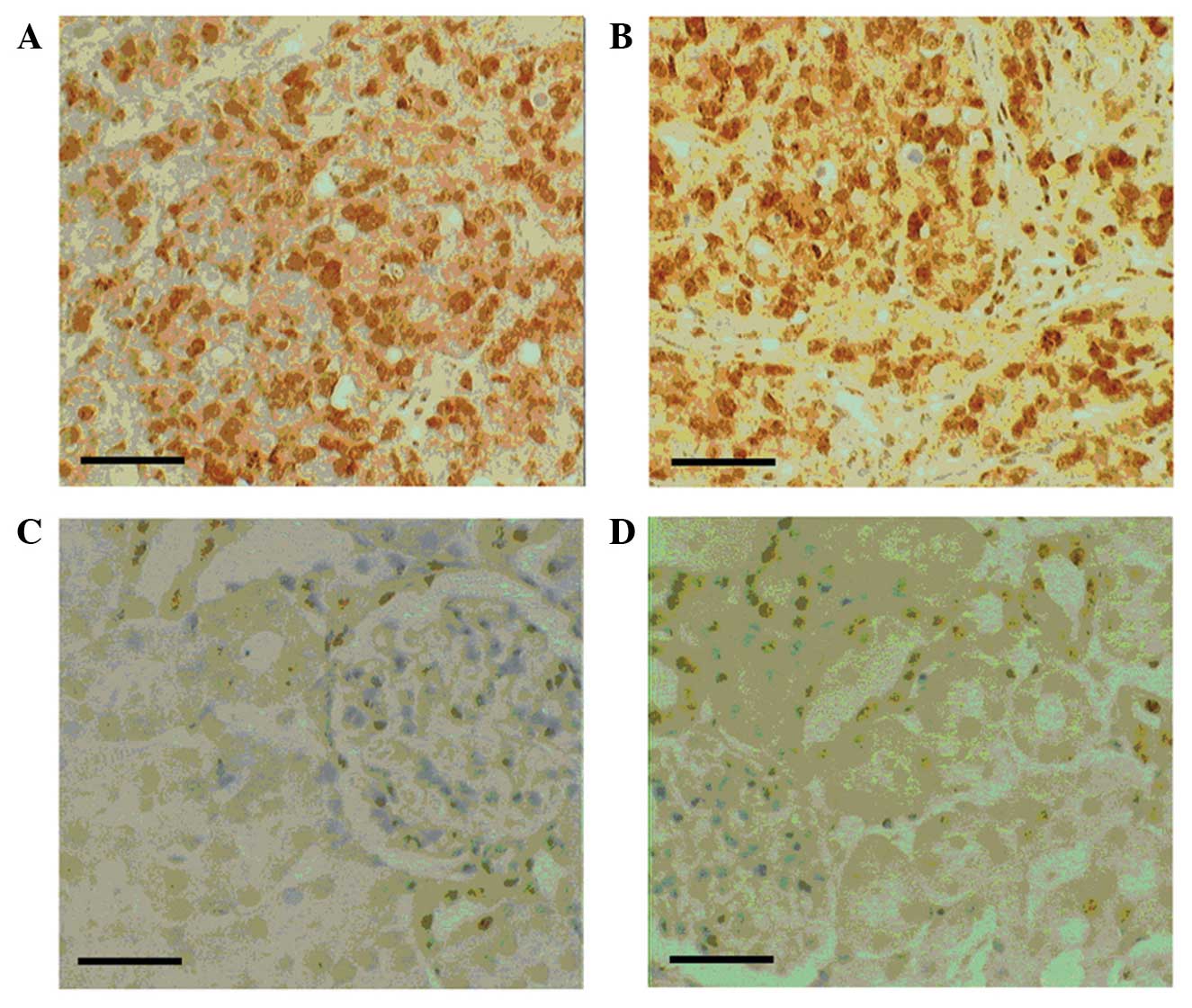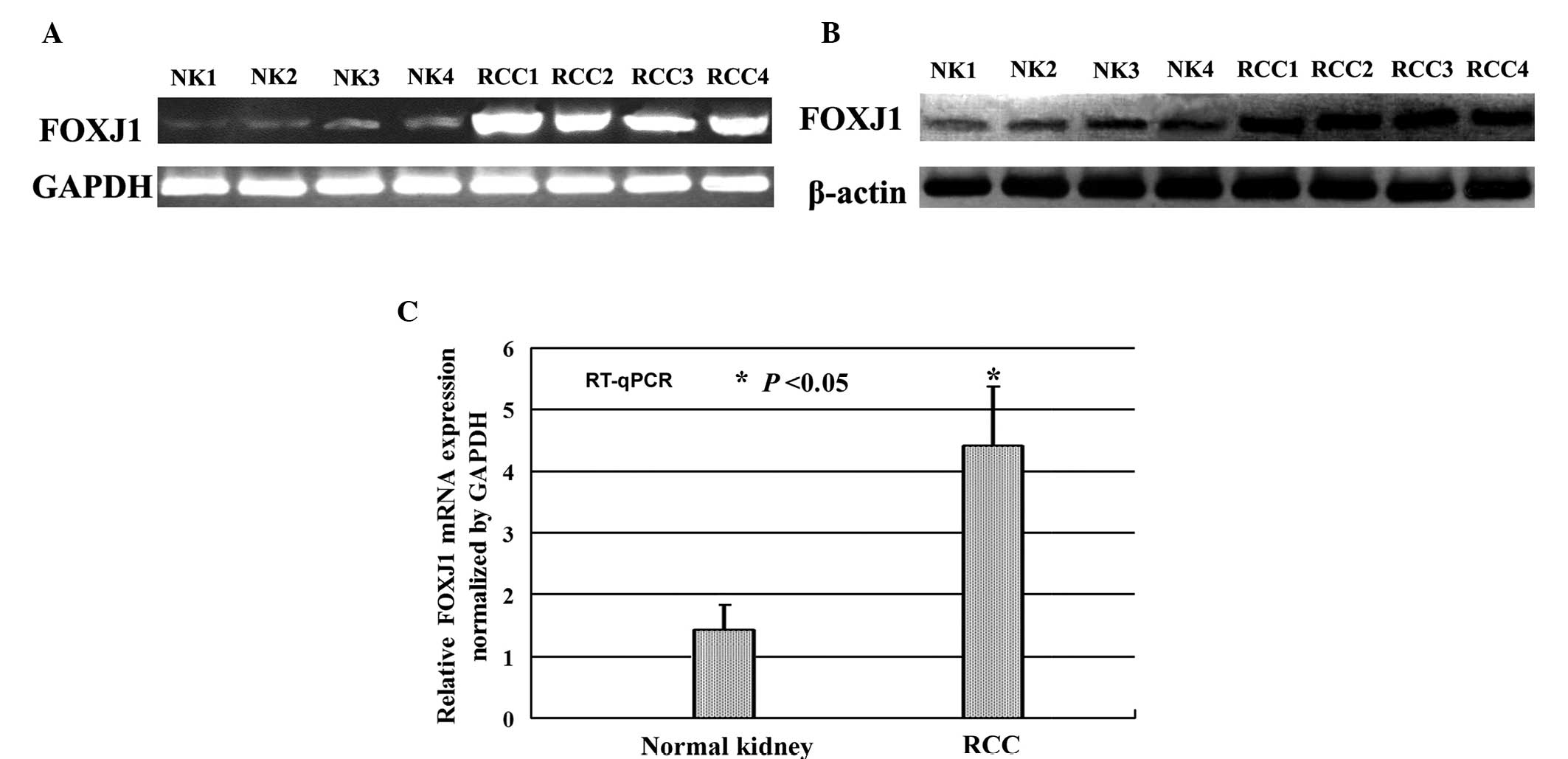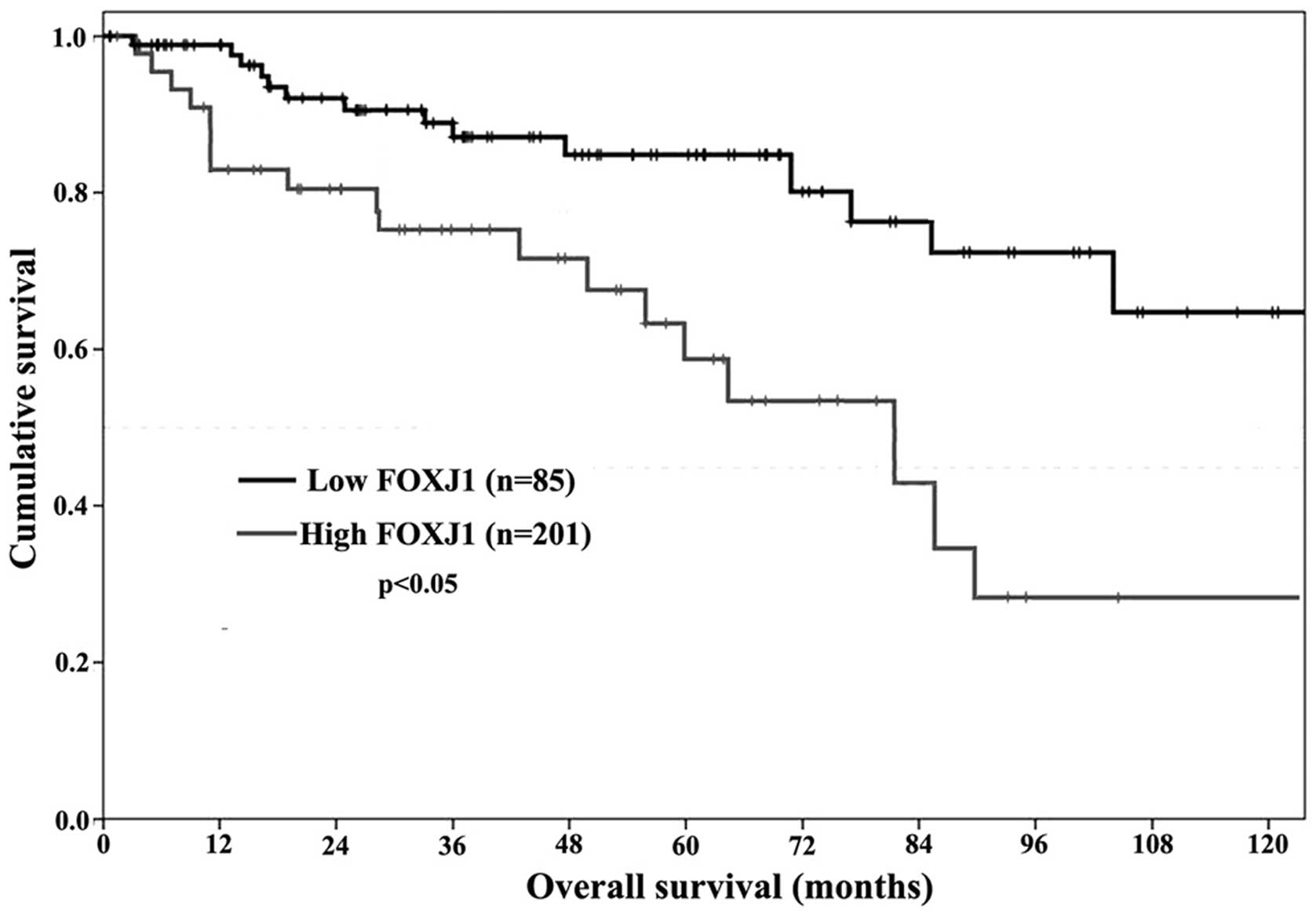|
1
|
Deng FM and Melamed J: Histologic variants
of renal cell carcinoma: does tumor type influence outcome? Urol
Clin North Am. 39:119–132. 2012. View Article : Google Scholar : PubMed/NCBI
|
|
2
|
Athar U and Gentile TC: Treatment options
for metastatic renal cell carcinoma: a review. Can J Urol.
15:3954–3966. 2008.PubMed/NCBI
|
|
3
|
Jemal A, Siegel R, Ward E, Murray T, Xu J,
Smigal C and Thun MJ: Cancer statistics, 2006. CA Cancer J Clin.
56:106–130. 2006. View Article : Google Scholar : PubMed/NCBI
|
|
4
|
Yu DS, Chang SY and Ma CP: The expression
of mdr-1-related gp-170 and its correlation with anthracycline
resistance in renal cell carcinoma cell lines and
multidrug-resistant sublines. Br J Urol. 82:544–547. 1998.
View Article : Google Scholar : PubMed/NCBI
|
|
5
|
Hartmann JT and Bokemeyer C: Chemotherapy
for renal cell carcinoma. Anticancer Res. 19:1541–1543.
1999.PubMed/NCBI
|
|
6
|
Sciarra A, Gentile V, Salciccia S,
Alfarone A and Di Silverio F: New anti-angiogenic targeted therapy
in advanced renal cell carcinoma (RCC): Current status and future
prospects. Rev Recent Clin Trials. 3:97–103. 2008. View Article : Google Scholar : PubMed/NCBI
|
|
7
|
Dalle S, Thieblemont C, Thomas L and
Dumontet C: Monoclonal antibodies in clinical oncology. Anticancer
Agents Med Chem. 8:523–532. 2008. View Article : Google Scholar : PubMed/NCBI
|
|
8
|
Coppin C: Immunotherapy for renal cell
cancer in the era of targeted therapy. Expert Rev Anticancer Ther.
8:907–919. 2008. View Article : Google Scholar : PubMed/NCBI
|
|
9
|
Simpson D and Curran MP: Temsirolimus: In
advanced renal cell carcinoma. Drugs. 68:631–638. 2008. View Article : Google Scholar : PubMed/NCBI
|
|
10
|
Myatt SS and Lam EW: The emerging roles of
forkhead box (Fox) proteins in cancer. Nat Rev Cancer. 7:847–859.
2007. View
Article : Google Scholar : PubMed/NCBI
|
|
11
|
Jackson BC, Carpenter C, Nebert DW and
Vasiliou V: Update of human and mouse forkhead box (FOX) gene
families. Hum Genomics. 4:345–352. 2010.PubMed/NCBI
|
|
12
|
Wonsey DR and Follettie MT: Loss of the
forkhead transcription factor FoxM1 causes centrosome amplification
and mitotic catastrophe. Cancer Res. 65:5181–5189. 2005. View Article : Google Scholar : PubMed/NCBI
|
|
13
|
Kim IM, Ackerson T, Ramakrishna S, et al:
The Forkhead Box m1 transcription factor stimulates the
proliferation of tumor cells during development of lung cancer.
Cancer Res. 66:2153–2161. 2006. View Article : Google Scholar : PubMed/NCBI
|
|
14
|
Lee JS, Chu IS, Heo J, et al:
Classification and prediction of survival in hepatocellular
carcinoma by gene expression profiling. Hepatology. 40:667–676.
2004. View Article : Google Scholar : PubMed/NCBI
|
|
15
|
Teh MT, Wong ST, Neill GW, Ghali LR,
Philpott MP and Quinn AG: FOXM1 is a downstream target of Gli1 in
basal cell carcinomas. Cancer Res. 62:4773–4780. 2002.PubMed/NCBI
|
|
16
|
Kalin TV, Wang IC, Ackerson TJ, et al:
Increased levels of the FoxM1 transcription factor accelerate
development and progression of prostate carcinomas in both TRAMP
and LADY transgenic mice. Cancer Res. 66:1712–1720. 2006.
View Article : Google Scholar : PubMed/NCBI
|
|
17
|
Yoshida Y, Wang IC, Yoder HM, Davidson NO
and Costa RH: The forkhead box M1 transcription factor contributes
to the development and growth of mouse colorectal cancer.
Gastroenterology. 132:1420–1431. 2007. View Article : Google Scholar : PubMed/NCBI
|
|
18
|
Laoukili J, Kooistra MR, Brás A, et al:
FoxM1 is required for execution of the mitotic programme and
chromosome stability. Nat Cell Biol. 7:126–136. 2005. View Article : Google Scholar : PubMed/NCBI
|
|
19
|
Costa RH: FoxM1 dances with mitosis. Nat
Cell Biol. 7:108–110. 2005. View Article : Google Scholar : PubMed/NCBI
|
|
20
|
Wang X, Kiyokawa H, Dennewitz MB and Costa
RH: The Forkhead Box m1b transcription factor is essential for
hepatocyte DNA replication and mitosis during mouse liver
regeneration. Proc Natl Acad Sci USA. 99:16881–16886. 2002.
View Article : Google Scholar : PubMed/NCBI
|
|
21
|
Wang IC, Chen YJ, Hughes D, et al:
Forkhead box M1 regulates the transcriptional network of genes
essential for mitotic progression and genes encoding the SCF
(Skp2-Cks1) ubiquitin ligase. Mol Cell Biol. 25:10875–10894. 2005.
View Article : Google Scholar : PubMed/NCBI
|
|
22
|
Accili D and Arden KC: FoxOs at the
crossroads of cellular metabolism, differentiation and
transformation. Cell. 117:421–426. 2004. View Article : Google Scholar : PubMed/NCBI
|
|
23
|
Hu MC, Lee DF, Xia W, et al: IkappaB
kinase promotes tumorigenesis through inhibition of forkhead
FOXO3a. Cell. 117:225–237. 2004. View Article : Google Scholar : PubMed/NCBI
|
|
24
|
Seoane J, Le HV, Shen L, Anderson SA and
Massagué J: Integration of Smad and forkhead pathways in the
control of neuroepithelial and glioblastoma cell proliferation.
Cell. 117:211–223. 2004. View Article : Google Scholar : PubMed/NCBI
|
|
25
|
Modur V, Nagarajan R, Evers BM and
Milbrandt J: FOXO proteins regulate tumor necrosis factor-related
apoptosis inducing ligand expression. Implications for PTEN
mutation in prostate cancer. J Biol Chem. 277:47928–47937. 2002.
View Article : Google Scholar : PubMed/NCBI
|
|
26
|
Parry P, Wei Y and Evans G: Cloning and
characterization of the t(X;11) breakpoint from a leukemic cell
line identify a new member of the forkhead gene family. Genes
Chromosomes Cancer. 11:79–84. 1994. View Article : Google Scholar : PubMed/NCBI
|
|
27
|
Ward EC, Hoekstra AV, Blok LJ, et al: The
regulation and function of the forkhead transcription factor,
Forkhead box O1, is dependent on the progesterone receptor in
endometrial carcinoma. Endocrinology. 149:1942–1950. 2008.
View Article : Google Scholar : PubMed/NCBI
|
|
28
|
Goto T, Takano M, Albergaria A, et al:
Mechanism and functional consequences of loss of FOXO1 expression
in endometrioid endometrial cancer cells. Oncogene. 27:9–19. 2008.
View Article : Google Scholar : PubMed/NCBI
|
|
29
|
Nucera C, Eeckhoute J, Finn S, et al:
FOXA1 is a potential oncogene in anaplastic thyroid carcinoma. Clin
Cancer Res. 15:3680–3689. 2009. View Article : Google Scholar : PubMed/NCBI
|
|
30
|
Lin L, Miller CT, Contreras JI, et al: The
hepatocyte nuclear factor 3 alpha gene, HNF3alpha (FOXA1), on
chromosome band 14q13 is amplified and overexpressed in esophageal
and lung adenocarcinomas. Cancer Res. 62:5273–5279. 2002.PubMed/NCBI
|
|
31
|
Sano H, Leboeuf JP, Novitskiy SV, et al:
The Foxc2 transcription factor regulates tumor angiogenesis.
Biochem Biophys Res Commun. 392:201–206. 2010. View Article : Google Scholar : PubMed/NCBI
|
|
32
|
Brody SL, Yan XH, Wuerffel MK, Song SK and
Shapiro SD: Ciliogenesis and left-right axis defects in forkhead
factor HFH-4-null mice. Am J Respir Cell Mol Biol. 23:45–51. 2000.
View Article : Google Scholar : PubMed/NCBI
|
|
33
|
Hackett BP, Brody SL, Liang M, Zeitz ID,
Bruns LA and Gitlin JD: Primary structure of hepatocyte nuclear
factor/forkhead homologue 4 and characterization of gene expression
in the developing respiratory and reproductive epithelium. Proc
Natl Acad Sci USA. 92:4249–4253. 1995. View Article : Google Scholar : PubMed/NCBI
|
|
34
|
Clevidence DE, Overdier DG, Tao W, et al:
Identification of nine tissue-specific transcription factors of the
hepatocyte nuclear factor 3/forkhead DNA-binding-domain family.
Proc Natl Acad Sci USA. 90:3948–3952. 1993. View Article : Google Scholar : PubMed/NCBI
|
|
35
|
Li CS, Zhang Q, Lim MK, et al: Association
of FOXJ1 polymorphisms with systemic lupus erythematosus and
rheumatoid arthritis in Korean population. Exp Mol Med. 39:805–811.
2007. View Article : Google Scholar : PubMed/NCBI
|
|
36
|
Li CS, Chae SC, Lee JH, Zhang Q and Chung
HT: Identification of single nucleotide polymorphisms in FOXJ1 and
their association with allergic rhinitis. J Hum Genet. 51:292–297.
2006. View Article : Google Scholar : PubMed/NCBI
|
|
37
|
Srivatsan S and Peng SL: Cutting edge:
Foxj1 protects against autoimmunity and inhibits thymocyte egress.
J Immunol. 175:7805–7809. 2005. View Article : Google Scholar : PubMed/NCBI
|
|
38
|
Lin L, Brody SL and Peng SL: Restraint of
B cell activation by Foxj1-mediated antagonism of NF-kappa B and
IL-6. J Immunol. 175:951–958. 2005. View Article : Google Scholar : PubMed/NCBI
|
|
39
|
Demircan B, Dyer LM, Gerace M, Lobenhofer
EK, Robertson KD and Brown KD: Comparative epigenomics of human and
mouse mammary tumors. Genes Chromosomes Cancer. 48:83–97. 2009.
View Article : Google Scholar : PubMed/NCBI
|
|
40
|
Chen HW, Huang XD, Li HC, et al:
Expression of FOXJ1 in hepatocellular carcinoma: correlation with
patients' prognosis and tumor cell proliferation. Mol Carcinog.
52:647–659. 2013. View
Article : Google Scholar : PubMed/NCBI
|
|
41
|
Elmore JM, Kadesky KT, Koeneman KS and
Sagalowsky AI: Reassessment of the 1997 TNM classification system
for renal cell carcinoma. Cancer. 98:2329–2334. 2003. View Article : Google Scholar : PubMed/NCBI
|
|
42
|
Hong SK, Jeong CW, Park JH, Kim HS, Kwak
C, Choe G, Kim HH and Lee SE: Application of simplified Fuhrman
grading system in clear-cell renal cell carcinoma. BJU Int.
107:409–415. 2011. View Article : Google Scholar : PubMed/NCBI
|
|
43
|
Abourbih S, Sircar K, Tanguay S, Kassouf
W, Aprikian A, Mansure J and Brimo F: Aldehyde dehydrogenase 1
expression in primary and metastatic renal cell carcinoma: an
immunohistochemistry study. World J Surg Oncol. 11:2982013.
View Article : Google Scholar : PubMed/NCBI
|
|
44
|
Dutta KK, Nishinaka Y, Masutani H, et al:
Two distinct mechanisms for loss of thioredoxin-binding protein-2
in oxidative stress-induced renal carcinogenesis. Lab Invest.
85:798–807. 2005. View Article : Google Scholar : PubMed/NCBI
|
|
45
|
Bustin SA, Benes V, Garson JA, et al: The
MIQE guidelines: Minimum information for publication of
quantitative real-time PCR experiments. Clin Chem. 55:611–622.
2009. View Article : Google Scholar : PubMed/NCBI
|
|
46
|
Goldman LA, Cutrone EC, Kotenko SV, Krause
CD and Langer JA: Modifications of vectors pEF-BOS, pcDNA1 and
pcDNA3 result in improved convenience and expression.
Biotechniques. 21:1013–1015. 1996.PubMed/NCBI
|













